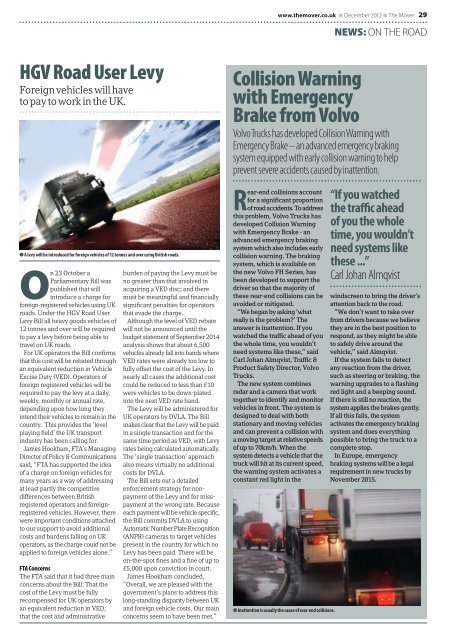The Mover December 2012
The Mover December 2012
The Mover December 2012
You also want an ePaper? Increase the reach of your titles
YUMPU automatically turns print PDFs into web optimized ePapers that Google loves.
www.themover.co.uk ● <strong>December</strong> <strong>2012</strong> ● <strong>The</strong> <strong>Mover</strong> 29NEWS: ON THE ROADHGV Road User LevyForeign vehicles will haveto pay to work in the UK.● A levy will be introduced for foreign vehicles of 12 tonnes and over using British roads.On 23 October aParliamentary Bill waspublished that willintroduce a charge forforeign-registered vehicles using UKroads. Under the HGV Road UserLevy Bill all heavy goods vehicles of12 tonnes and over will be requiredto pay a levy before being able totravel on UK roads.For UK operators the Bill confirmsthat this cost will be rebated throughan equivalent reduction in VehicleExcise Duty (VED). Operators offoreign registered vehicles will berequired to pay the levy at a daily,weekly, monthly or annual rate,depending upon how long theyintend their vehicles to remain in thecountry. This provides the ‘levelplaying field’ the UK transportindustry has been calling for.James Hookham, FTA’s ManagingDirector of Policy & Communicationssaid, “FTA has supported the ideaof a charge on foreign vehicles formany years as a way of addressingat least partly the competitivedifferences between Britishregistered operators and foreignregisteredvehicles. However, therewere important conditions attachedto our support to avoid additionalcosts and burdens falling on UKoperators, as the charge could not beapplied to foreign vehicles alone.”FTA Concerns<strong>The</strong> FTA said that it had three mainconcerns about the Bill: That thecost of the Levy must be fullyrecompensed for UK operators byan equivalent reduction in VED;that the cost and administrativeburden of paying the Levy must beno greater than that involved inacquiring a VED disc; and theremust be meaningful and financiallysignificant penalties for operatorsthat evade the charge.Although the level of VED rebatewill not be announced until thebudget statement of September 2014analysis shows that about 6,500vehicles already fall into bands whereVED rates were already too low tofully offset the cost of the Levy. Innearly all cases the additional costcould be reduced to less than £10were vehicles to be down-platedinto the next VED rate band.<strong>The</strong> Levy will be administered forUK operators by DVLA. <strong>The</strong> Billmakes clear that the Levy will be paidin a single transaction and for thesame time period as VED, with Levyrates being calculated automatically.<strong>The</strong> ‘single transaction’ approachalso means virtually no additionalcosts for DVLA.<strong>The</strong> Bill sets out a detailedenforcement strategy for nonpaymentof the Levy and for misspaymentat the wrong rate. Becauseeach payment will be vehicle specific,the Bill commits DVLA to usingAutomatic Number Plate Recognition(ANPR) cameras to target vehiclespresent in the country for which noLevy has been paid. <strong>The</strong>re will beon-the-spot fines and a fine of up to£5,000 upon conviction in court.James Hookham concluded,“Overall, we are pleased with thegovernment’s plans to address thislong-standing disparity between UKand foreign vehicle costs. Our mainconcerns seem to have been met.”Collision Warningwith EmergencyBrake from VolvoVolvo Trucks has developed Collision Warning withEmergency Brake – an advanced emergency brakingsystem equipped with early collision warning to helpprevent severe accidents caused by inattention.Rear-end collisions accountfor a significant proportionof road accidents. To addressthis problem, Volvo Trucks hasdeveloped Collision Warningwith Emergency Brake - anadvanced emergency brakingsystem which also includes earlycollision warning. <strong>The</strong> brakingsystem, which is available onthe new Volvo FH Series, hasbeen developed to support thedriver so that the majority ofthese rear-end collisions can beavoided or mitigated.“We began by asking ‘whatreally is the problem?’ <strong>The</strong>answer is inattention. If youwatched the traffic ahead of youthe whole time, you wouldn’tneed systems like these,” saidCarl Johan Almqvist, Traffic &Product Safety Director, VolvoTrucks.<strong>The</strong> new system combinesradar and a camera that worktogether to identify and monitorvehicles in front. <strong>The</strong> system isdesigned to deal with bothstationary and moving vehiclesand can prevent a collision witha moving target at relative speedsof up to 70km/h. When thesystem detects a vehicle that thetruck will hit at its current speed,the warning system activates aconstant red light in the● Inattention is usually the cause of rear-end collisions.“If you watchedthe traffic aheadof you the wholetime, you wouldn’tneed systems likethese ...”Carl Johan Almqvistwindscreen to bring the driver’sattention back to the road.“We don’t want to take overfrom drivers because we believethey are in the best position torespond, as they might be ableto safely drive around thevehicle,” said Almqvist.If the system fails to detectany reaction from the driver,such as steering or braking, thewarning upgrades to a flashingred light and a beeping sound.If there is still no reaction, thesystem applies the brakes gently.If all this fails, the systemactivates the emergency brakingsystem and does everythingpossible to bring the truck to acomplete stop.In Europe, emergencybraking systems will be a legalrequirement in new trucks byNovember 2015.



